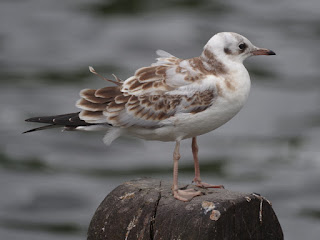There was one chick at the Vista ..
... but the biggest brood, and the one with the best chance of survival, is at Bluebird Boats. When danger threatens, in this case a violent little boy, they can run under the platform.
A side view, looking through the bridge, of the Great Crested Grebes' nest under the willow.
The Tufted Duck on the Serpentine is now sadly down to her last duckling. She was looking after it carefully, but it's very small and in a dangerous place.
However, the two Mallard families on the Long Water continue to prosper, and both of them turned up at Peter Pan at different times.
The two Mallard ducklings on the Serpentine were still there, but there were too many people saying 'Aren't they cute' in front of them for me to get a picture.
A pair of Mandarins were chewing algae off the posts at the Vista. The male, now completely in eclipse but recognisable by his pink bill, is on the right.
The two Bar-Headed x Greylag Goose hybrids which came up from St James's Park to the Serpentine to moult can now fly again, but are staying here for the time being.
After a grey and slightly drizzly morning the weather improved and the male Little Owl near the Albert Memorial emerged on his usual oak tree.
The Reed Warbler family near the Diana Memorial were bustling around. I think there are two young ones.
The familiar Coal Tit near the bridge who comes to my hand has regrown the feathers on her head and is looking smart again.
The female Great Tit on the other side of the Long Water has also recovered from the tattiness caused by raising young.
A Buff-Tailed Bumblebee worked its way over a thistle.
This is the view over the Vista towards Kensington Palace in the mid-18th century. You are standing just where the Henry Moore sculpture is now. It would have horrified the elegant people strolling about. The Queen's Temple is visible at the left.
Both the lake and the temple were completed in the early 1730s. Kensington Gardens remained the private garden of the palace, but visitors were allowed in on Sunday afternoons if they were respectably dressed. As far as I know, it was possible to go down to the edge of the water here until 1922, when the east side of the Long Water was railed off as a bird sanctuary.

















































